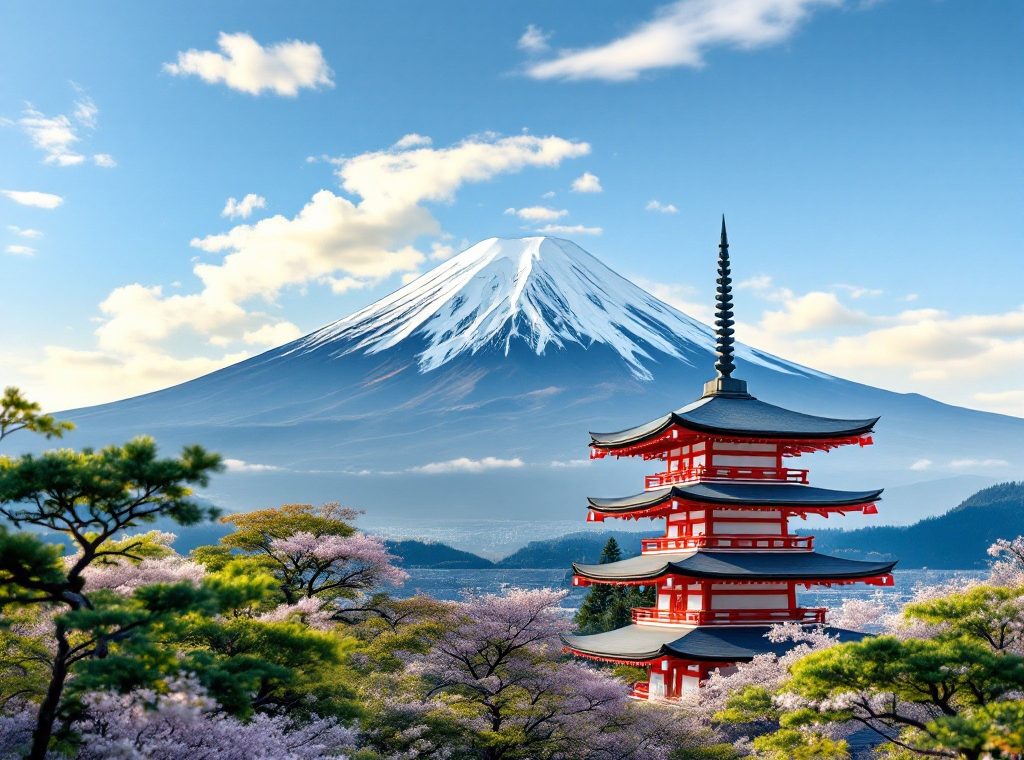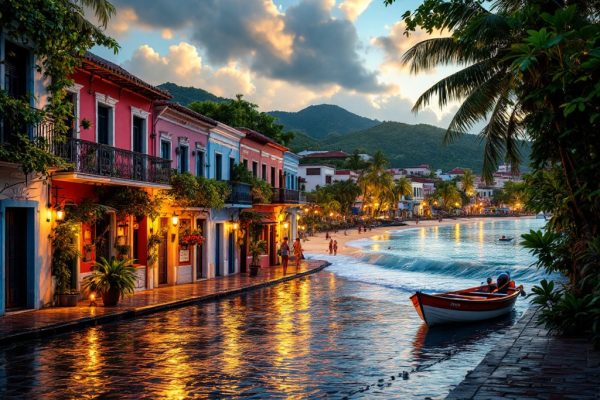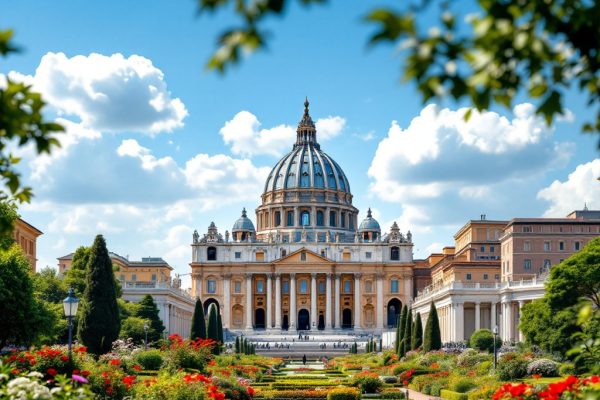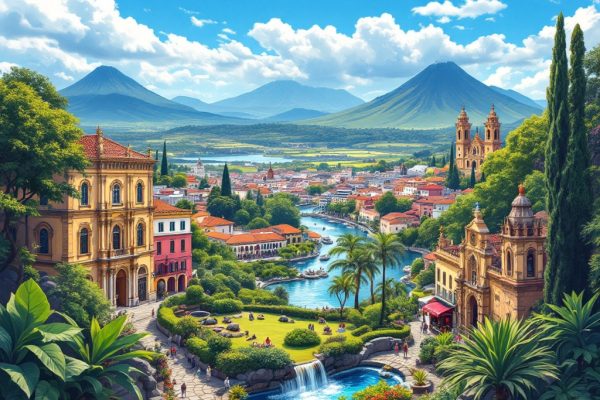Japan Tourist Attractions: Mount Fuji, Pagodas, and More
Discover Japan’s majestic Mount Fuji, a sacred volcano and UNESCO World Heritage site. Towering at 3,776 meters, this iconic peak offers breathtaking views and inspiring cultural experiences. Explore ancient shrines, hike scenic trails, and capture stunning photos from the Fuji Five Lakes. Plan your unforgettable Mount Fuji adventure today!
Important information
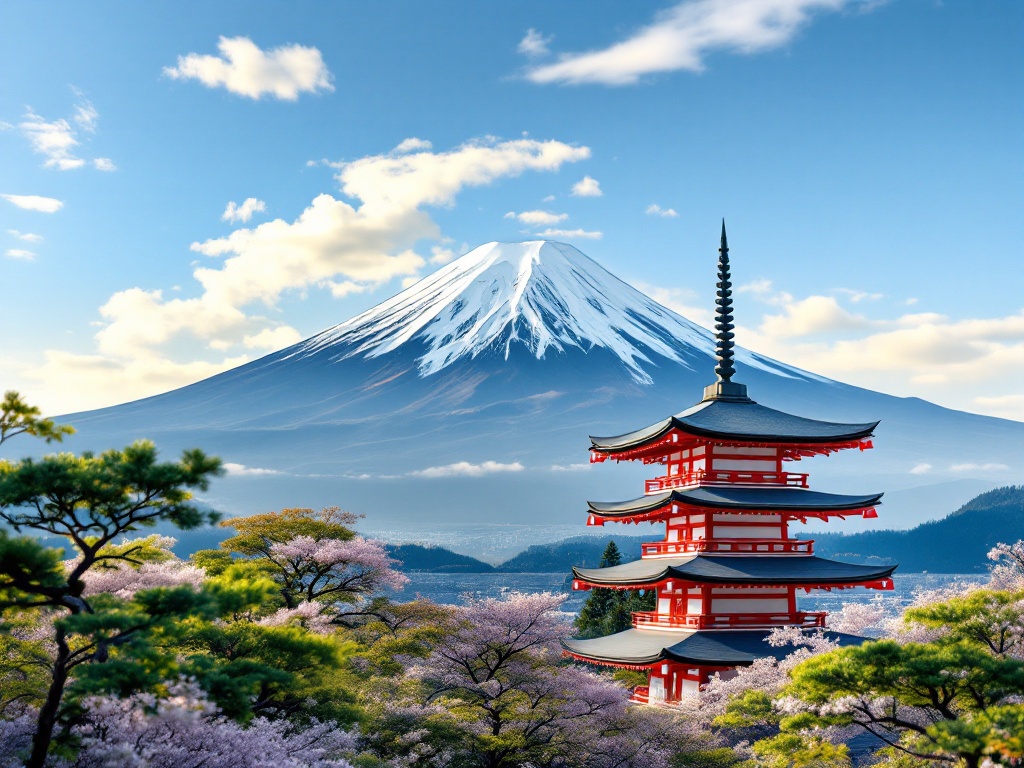
- Mount Fuji, Japan’s highest peak at 3,776 meters, is an active volcano located on Honshu Island.
- It’s a UNESCO World Heritage site, revered as sacred in Japanese culture and frequently depicted in art.
- The official climbing season is July and August, with various trails leading to the summit.
- The Fuji Five Lakes region offers stunning views, with each lake providing unique perspectives.
- Various transportation options, including the Shinkansen bullet train and buses, make Mount Fuji accessible from major cities.
Discovering Japan’s Iconic Mount Fuji
Japan’s iconic Mount Fuji, standing tall at 3,776 meters, reigns as the nation’s highest peak. Located on Honshu Island, this majestic mountain is also an active volcano, though its last eruption occurred in 1707. Revered as sacred in Japanese culture, Mount Fuji is recognized as a UNESCO World Heritage site, drawing climbers and sightseers alike to experience its breathtaking beauty.
Mount Fuji: Japan’s Highest Mountain
Mount Fuji, Japan’s tallest peak, reaches a height of 3,776 meters and is situated on the border of Yamanashi and Shizuoka prefectures, about 100 kilometers southwest of Tokyo. Located within the Fuji-Hakone-Izu National Park, the mountain is famous for its nearly perfectly symmetrical cone, an iconic image recognized globally.
Mount Fuji: An Active Volcano
Mount Fuji, an active stratovolcano, last erupted in 1707 during the Edo period. This two-week event, known as the Hoei eruption, created a new crater and a second peak. It didn’t produce lava flows, instead ejecting enormous quantities of volcanic ash that blanketed the surrounding landscape.
Mount Fuji: A Sacred Mountain Revered by Many
Mount Fuji, revered as sacred in Japan, symbolizes beauty and strength and holds profound spiritual significance within the culture. For centuries, it has been a site of worship and is frequently depicted in art and literature. As one of Japan’s “Three Holy Mountains,” this iconic landmark holds a special place in the nation’s heart.
Why Mount Fuji is a UNESCO World Heritage Site
Japan’s Mount Fuji, revered as sacred and a muse for artists, became a UNESCO World Heritage Site in 2013. Its iconic snow-capped cone has inspired countless works of art for centuries, captivating poets and painters alike. This recognition cemented its status as a global treasure, celebrating both its cultural significance and natural splendor.
Artistic Inspiration and Cultural Significance
Mount Fuji, an iconic symbol of Japan, has profoundly influenced the nation’s art and literature for centuries. Its majestic peak has been immortalized in countless paintings, poems, and woodblock prints, most notably in Katsushika Hokusai’s renowned “Thirty-six Views of Mount Fuji” series. In Japanese culture, the mountain represents beauty, strength, and good fortune. Mount Fuji also holds deep spiritual significance, evidenced by the numerous Shinto and Buddhist shrines and temples scattered across its slopes and surrounding areas. More than a natural wonder, Mount Fuji stands as a cultural icon, a status cemented by its designation as a UNESCO World Heritage Site. This recognition acknowledges both its natural splendor and cultural importance.
Mount Fuji in Japanese Culture
Mount Fuji holds a powerful symbolic meaning in Japan, frequently appearing in art, literature, and photography. Sacred to both Shinto and Buddhist traditions, the mountain inspires numerous festivals and customs, significantly enriching Japan’s cultural heritage. Its iconic image embodies beauty, strength, and good fortune.
Seasonal Views: Best Time to See Mount Fuji
Mount Fuji offers stunningly clear views in winter thanks to the dry air and minimal atmospheric haze. Ironically, the mountain’s official climbing season is during the summer months of July and August.
Climbing Mount Fuji: A Popular Adventure
Mount Fuji’s iconic peak attracts thousands of hikers every year. The official climbing season runs through July and August, welcoming climbers of all skill levels. Several routes lead to the summit. The Yoshida Trail, starting at the 5th Station, is a popular option. Other routes include the Subashiri, Fujinomiya, and Gotemba Trails, each offering unique challenges and scenic variety.
Top Viewing Spots for Mount Fuji
Viewing Mount Fuji from the Chureito Pagoda offers a classic, picture-perfect composition, especially breathtaking during cherry blossom season. The Fuji Five Lakes region presents a variety of stunning perspectives on the majestic mountain.
Lake Kawaguchi
Known for its clear, reflective waters, Lake Kawaguchi is a photographer’s dream for capturing Mount Fuji’s magnificence.
Lake Yamanaka
As the largest of the five lakes, Lake Yamanaka provides opportunities for boating, fishing, and other recreational activities.
Hakone
Hakone offers scenic woodland views of Mount Fuji, beautifully framed by forests and volcanic hot springs.
Oishi Park and Momiji Corridor
These locations are renowned for their vibrant autumn foliage, creating a striking contrast against Mount Fuji.
Shiraito Falls
Shiraito Falls presents a picturesque cascade, often with Mount Fuji visible in the background on clear days.
Lake Shoji
Lake Shoji provides tranquil surroundings and magical sunrise views of Mount Fuji, perfect for peaceful contemplation.
Chureito Pagoda: Iconic Views of Mount Fuji
Nestled within the grounds of Arakura Sengen Shrine, the five-storied Chureito Pagoda offers stunning panoramic views of Mount Fuji. Built in 1963 as a peace memorial, it overlooks the charming Fujiyoshida City and attracts photographers year-round. The pagoda is particularly popular during April’s cherry blossom season and November’s vibrant autumn foliage. Conveniently located a short walk from Shimo-Yoshida Station, the pagoda is easily accessible to visitors.
Fuji Five Lakes: Scenic Views and Photography Spots
Kawaguchiko, the most accessible lake, provides classic Fuji vistas, particularly stunning during cherry blossom season. Yamanakako, the largest of the five, is a haven for water sports enthusiasts, with Fuji serving as a breathtaking backdrop.
Saiko’s rugged shoreline creates dramatic and compelling compositions. The tranquil waters of Shojiko perfectly mirror the mountain’s iconic form.
Motosuko, famed for its crystal-clear water, offers views so breathtaking they’re featured on the 5,000 yen note. Photographers will find endless inspiration in the varied foreground elements and distinct angles each lake provides, capturing stunning and diverse images of this celebrated peak.
Lake Kawaguchi: Prime Location for Mount Fuji Photography
Lake Kawaguchi, nestled in the renowned Fuji Five Lakes region, captivates visitors with breathtaking reflections of Mount Fuji on its pristine waters. It’s a haven for photographers seeking iconic shots. Beyond its visual splendor, Lake Kawaguchi offers recreational activities such as boating and hiking, enhancing its appeal to a global audience.
Lake Yamanaka: Largest Lake Near Mount Fuji
As the largest of the Fuji Five Lakes, Lake Yamanaka offers breathtaking views of Mount Fuji. Visitors can enjoy a variety of activities, including:
- boating,
- fishing,
- a variety of water sports.
Camping and hiking are also popular pastimes, making Lake Yamanaka an ideal destination for outdoor enthusiasts.
Hakone: Woodland Views of Mount Fuji
Escape to Hakone and experience tranquil views of Mount Fuji surrounded by vibrant forests. Famous for its rejuvenating hot springs and renowned art museums, Hakone offers a unique blend of relaxation and scenic beauty. It’s the perfect destination for those seeking peace and breathtaking natural landscapes.
Oishi Park and Momiji Corridor: Stunning Autumn Views
Oishi Park, nestled on the shores of Lake Kawaguchiko, offers breathtaking views of Mount Fuji, especially striking during the autumn months. The park’s Momiji Corridor, a lakeside path bordered by maple trees, is renowned for its stunning fall foliage. This picturesque corridor provides an ideal vantage point to admire the majestic mountain.
Shiraito Falls: Scenic Waterfall with Mount Fuji Backdrop
Shiraito Falls in Fujinomiya, Shizuoka Prefecture, is a breathtaking spectacle. Water cascades over moss-covered rocks, creating a stunning visual display. The backdrop of majestic Mount Fuji adds a remarkable contrast to the scene.
Lake Shoji: Magical Sunrise Views
Visitors to Lake Shoji are greeted by breathtaking sunrise views of Mount Fuji. Its majestic reflection shimmers on the tranquil water. This serene and magical scene is a photographer’s paradise, captivating nature lovers.
Exploring Cultural and Historical Sites Near Mount Fuji
- Arakura Sengen Shrine is renowned for its five-storied pagoda and offers stunning views of Mount Fuji.
- Kitaguchi Hongu Fuji Sengen Shrine serves as both an important place of worship and a common starting point for climbers.
- Experience traditional regional architecture at Saiko Iyashi-no-Sato Nenba, a reconstructed village.
- Oshino Hakkai, the “Eight Sacred Ponds,” is a historical site showcasing natural springs and traditional houses.
Arakura Sengen Shrine: Cultural Insights and Scenic Views
Arakura Sengen Shrine is a renowned Shinto shrine boasting breathtaking views of Mount Fuji. Dedicated to Konohanasakuya-hime, the goddess of the majestic peak, it serves as a popular starting point for climbers. It is also a tranquil sanctuary for prayer and reflection, allowing visitors to immerse themselves in the surrounding natural beauty.
Kitaguchi Hongu Fuji Sengen Shrine: A Sacred Place
Kitaguchi Hongu Fuji Sengen Shrine, a prominent Shinto shrine, embodies a profound reverence for Mount Fuji and honors its deity, Princess Konohanasakuya-hime. Climbers frequently begin their ascents here, seeking blessings for a safe journey. Nestled amidst natural beauty, the shrine provides a tranquil retreat.
Saiko Iyashi-no-Sato Nenba: A Traditional Japanese Village
Saiko Iyashi-no-Sato Nenba, located on the shores of Lake Saiko, is a reconstructed village featuring traditional thatched-roof houses. These preserved homes offer a glimpse into rural life around the Fuji Five Lakes region. Explore the unique architecture, discover local crafts, and enjoy breathtaking views of Mount Fuji.
Oshino Hakkai: The Healing Village
Nestled in the heart of Japan, Oshino Hakkai village offers a captivating blend of natural beauty and cultural heritage. The eight sacred ponds, mirroring the majestic Mount Fuji, are a truly breathtaking spectacle. These crystal-clear ponds are fed by pristine underground snowmelt from the mountain itself. The village also boasts historic thatched-roof houses, showcasing traditional Japanese architecture and providing a glimpse into the local way of life. A visit to Oshino Hakkai promises an unforgettable experience, immersing you in the serene beauty of Japan.
How to Visit and Enjoy Mount Fuji
Traveling to Mount Fuji from major Japanese cities is convenient. From Tokyo or Yokohama, various train and bus options are available. The Shinkansen bullet train provides a fast trip to Odawara, where you can transfer to the Hakone Tozan Railway. Direct buses also run from Tokyo to the Fuji Five Lakes area. Travelers from Yokohama can take a train to Odawara and then connect to a local bus. For a personalized journey, consider renting a car, but be mindful of mountain driving conditions, parking limitations, and possible traffic congestion.
Best Ways to Travel to Mount Fuji
Traveling to Mount Fuji is easy and convenient, with several transportation options available.
From Tokyo
The Tokaido Shinkansen offers a fast and scenic ride to Shin-Fuji Station, providing breathtaking views along the way. Buses also run from Tokyo and nearby areas, offering direct routes to Mount Fuji and its attractions.
From Kyoto
Traveling from Kyoto involves a train journey with transfers, potentially in Osaka.
Independent Travel
Rent a car for independent exploration and flexibility.
Organized Tours
Organized tours offer a hassle-free experience, managing all transportation and logistics.
Local Buses
Local buses connect nearby stations like Fujisan Station and Kawaguchiko Station to trailheads and viewpoints, providing convenient access to the mountain’s beauty.
From Tokyo and Yokohama: Viewing Mount Fuji
On a clear day, Mount Fuji is visible from Tokyo and Yokohama. In Tokyo, visit the Tokyo Metropolitan Government Building for panoramic city views with Mount Fuji as a backdrop. The Nihondaira Ropeway, accessible from both cities, offers breathtaking views of this iconic peak.
For potential Fuji sightings in Yokohama, consider the Landmark Tower or Osanbashi Pier. The Nihondaira Ropeway, accessible from both cities, also provides breathtaking perspectives of Mount Fuji.

